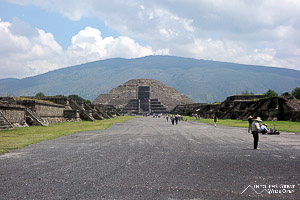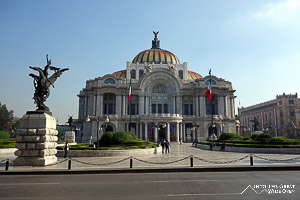Mexico City, Mexico
Humanity Amidst a Sea of Buildings
September 2, 2015
Going on, my first impression, I recall you wearing white
There was something sweet in the air, babe, that summer night
There will always be another time for us to fall in love
But it never cuts you quite as deep as that first time
You'll find out that the deepest cut is the first time
The first times always cut the deepest
- Vance Joy

It seems strange that more people don’t visit Mexico City. From Houston there are numerous direct flights and it is under two hours of flying time; it is similarly close to other urban areas in the southern United States. Perhaps many people are intimidated by the size; some estimates put the greater Mexico City area population at 22.5 million while the city proper has a population of nearly 9 million. Others may be scared off by the violence associated with the drug cartels that has racked other areas of the country, notably the areas in the north near the border with the United States and those on the Pacific coast. This violence has all too often found itself on the front pages of international news media, undoubtedly affecting the public perception of the country as a whole. Sadly this does the country a great disservice. One defining characteristic about Mexico as of late has been its uneven development; as many strides towards modernity that Mexico City has made, the rest of the country has not followed. Maybe it was because of this that I was pleasantly surprised during the time I spent in Mexico City.

The first thing that surprised me about the city was how big, sprawling, and diverse it really was. The crowded and dense Centro Historico features the immense main plaza, the Zocalo, bordered by the Metropolitan Cathedral and the National Palace. The side streets in this neighborhood bustle with activity and numerous old churches dot vibrant plazas that are hives of activity for the local residents. From the ancient Aztec ruins of the Templo Mayor to the sinking Iglesia de Nuestra Señora de Loreto to the colorful murals inside the National Palace, this neighborhood has a mix of everything. Just to the west is the tranquil neighborhood of Alameda Central with the beautifully ornate Palacio de Bellas Artes, the peaceful park, staggering views from the top of the Torre Latinoamericana, and Diego Rivera’s famous mural of the diversity of life in a Mexico City park.
Crossing over Paseo de la Reforma, one of the main streets in the city, there is the grandiose Monument of the Revolution, a structure that almost looks like it belongs in communist USSR. The Paseo de la Reforma is dotted with statues and monuments every few blocks, none grander than the Angel of Independence. This is area is one of main business districts in Mexico City and is lined with high-end office buildings and many restaurants. The weekend I was visiting happened to coincide with the Mexico City marathon so the entire Paseo de la Reforma was closed on Sunday morning as thousands of runners made their way across the city. Normally half of this main street is closed for a few hours on Sunday morning for runners and cyclists but with the marathon there was a band playing and thousands of spectators lined the course route.

At the western end of Paseo de la Reforma lies one of the entrances to Chapultepec Park, something like Mexico City’s version of Central Park. The enormous park features a large wooded area, a lake, a hilltop castle, and numerous museums. If you go on any Sunday afternoon the park is packed with local people enjoying the outdoors and all the attractions within the park. The main pedestrian pathways through the park are lined with vendors selling all sorts of things and paddleboats meander across the lake. Chapultepec Castle, the former residence of many presidents, is perched at the top of the hill in the park and its numerous rooms are filled with comprehensive exhibits and artefacts from throughout Mexico’s history. Also located in Chapultepec Park is the outstanding National Museum of Anthropology. This amazingly comprehensive museum features twelve halls with a stunning variety of artefacts from all regions of Mexico from the Pre-Colombian era onward, including excellently detailed Aztec items like the famous Sun Stone.
To become more acquainted with the Aztec culture a day trip to the nearby ruins of Teotihuacan is highly recommended. Located about 45 minutes by bus from Mexico City this large archeological site is contains the ruins of the Pyramid of the Sun, Pyramid of the Moon, and the rest of this ancient Aztec city. The gigantic Pyramid of the Sun is 220 meters wide and 65 meters tall while the smaller Pyramid of the Moon lies at the end of the Avenue of the Dead, the main street of the ruined city. Strolling through the spacious grounds under the hot afternoon sun gives you an idea of the size and grandeur of this former empire.

The bus trip to Teotihuacan also passes through the suburbs of Mexico City and offers a different perspective of the city. On the outskirts of the city the informal settlements climb high up on the edges of the low lying hills forming a distinct line with densely inhabited urban areas below the green tree line of the steeper slopes of the hills. This disparity is remarkable and shows just how rapidly the city has grown, outstripping any planned urban development that the government may have intended.
The growth and spread of the city has only exacerbated the traffic and congestion on the city’s roads. Fortunately, the extensive and easy to use metro system allows for easy accessibility of nearly all of the city’s neighborhoods and much of the city remains very walkable. After many months of living in Houston, a largely suburban city without much street life, Mexico City was a welcome change. The opportunity to walk through Mexico City’s neighborhoods and discover historic buildings, taco stands, small churches, and busy plazas was invigorating. There were so many police that nearly everywhere I went, at least in the central areas, it felt very safe, even in the evenings.

The only downside to my visit was that in late August and early September there were nearly daily thunderstorms and rain showers in the early evening. The cold rain around sunset made it difficult to get around and after a full day of exploring the city and sightseeing it made it easy to take shelter in the hotel room rather than experience the city’s nightlife. One thing the rain didn’t stop me from experiencing was the excellent food in Mexico City. From taquerias with super tasty assortments of tacos and arrays of toppings to mouthwatering overstuffed Mexican sandwiches called tortas to Mexican regional dishes and beverages that I sampled at a cultural festival at the Zocalo, I was pleasantly surprised by the food. Not only was it very affordable but everything seemed to be fresh, well prepared, and bursting with flavor. The best example of this was the popular and upscale Mercado Roma, truly a must visit for all the tasty food, everything from ceviche to pozole to fruit juices, and much more.
In my three days in Mexico City I saw a lot and certainly grasped the flavor of the city but ideally I would have had one or two additional days because there were several neighborhoods, like Condessa, Coyoacan, and San Angel, that I didn’t have time to visit. I suppose it is always good to save something for a return visit and being so close to the United States and offering so much to see, Mexico City is high on my list.
Sometimes when you visit a place and have good experiences it causes you to see that place in a different light, no matter what others may say, and, as I’ve found in return visits to other places, you will forever judge that place by your initial experiences. From those first impressions there is no way of telling how your perceptions may change as you yourself change but one of the joys of traveling is that the promise of the next trip is an unwritten page.
























































































